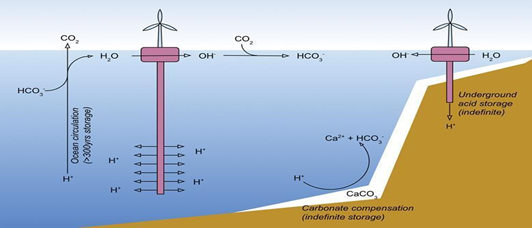Recent research published in Energy and Environmental Science suggests a new potential method for relocating surface seawater acidity into the depths of the ocean, which will not only help fight ocean acidification on the surface but will also allow the ocean to capture more CO2 from the atmosphere. This has the potential to help fight climate change, caused by high levels of carbon in the atmosphere. Here are the study’s main takeaways:
- The research was authored by Google employees Mike Tyka, Researcher in Computational Biophysics and Biochemistry, John Platt, Director of Applied Science, and Christopher Van Arsdale, Climate and Energy R&D.
- The proposal to pump surface acidity to the deep ocean would stabilize ocean acidification, thus amplifying the ocean’s ability to capture CO2 from the atmosphere without increasing ocean acidification. (more…)
- The proposed project’s simulation method demands two primary requirements, seawater and energy. (more…)
- The cost for the proposed project is estimated to be cheaper than other existing CO2 removal methods. (more…)
Background Information: Ocean Acidification Infographic: What Is Ocean Acidification?
Full Research Paper: CO2 Capture By Pumping Surface Acidity To The Deep Ocean
Stabilizing Acidification And Increasing The Ocean’s Co2 Capture
The researchers propose a mechanism designed to accelerate the downward movement of acidity from the top of the ocean to its depths. Researchers argue that moving acidity to the depths of the ocean mirrors the natural biological carbon pump, and allows carbon to be stored in the deep ocean. This, in turn, would decrease surface acidity (helping to control ocean acidification) and allow the ocean to absorb an increased amount of carbon dioxide from the atmosphere., Here’s how they plan to do it:
- Through a pumping process, the alkaline discharge or the base would be transported up to the surface water, and the acidic water from the surface would be transported deep down into the ocean floor. This increases the alkaline level on the surface water and regulates the acidity or pH level.
- It’s estimated that during a 50-year span of utilizing the proposed method, approximately 3 gigatons of carbon suspended in the atmosphere could be eliminated, and it would only lower the deepwater acidity level by 0.2.
- With regulated surface water pH levels, coral reefs and other shell-forming marine animals will thrive, as these are the species that are most damaged or affected by ocean acidification.
How Will This Work? Requirements and Process of Acidity Pumping
The proposed project’s method demands two primary requirements for the process to function.
Seawater
⮚ One of the primary requirements of the proposed project is seawater. It is critical since it is the primary focus of the research, and may also be utilized as a source of energy.
Energy
⮚ Another primary requirement is energy, as it is essential for any mechanism to function. The energy needed could be generated through waves that come from the open ocean, wind energy that can be harnessed offshore, or ocean thermal energy conversion, where energy is generated through temperature variations in ocean waters.
Process
⮚ Through electrochemical pumping, the saltwater will be separated into acid and base. After this separation process, the acidic water will be released into the depths of the ocean, and the base which will be released in the surface water, which will stabilize the pH level, allowing the ocean to capture more carbon in the atmosphere. Acidity on the ocean floor will accelerate the breakdown of alkaline sediments on the ocean floor, thereby reducing acidity.
The image below illustrates how the pumping of acidity from surface water would accelerate the natural weathering of sedimentary carbonates on the ocean floor. Through this proposed process, carbon is stored in ocean depths and alkaline carbonate deposits dissolve (both of which reduce acidity), while carbon dioxide uptake is increased at the surface.

The Cost of Surface Acidity Pumping Is Estimated To Be Cheaper Than Other Methods
The proposed project estimate cost per ton of captured CO2 appears to be less expensive than other existing CO2 removal methods. Below are the following estimates for each method:
⮚ Pumping surface acidity to the deep ocean is anticipated to cost $93–$297 for each ton of CO2 captured by the proposed project.
⮚ Another method of removing carbon is called CO2 extraction, which is estimated to cost $373–$604 for every ton of CO2 captured.
⮚ Direct air capture of carbon is estimated to cost $89–$506 per ton of CO2captured.
⮚ The terrestrial weathering method is estimated to cost $24–$578 per ton of CO2captured.
Sources:
“CO2 capture by pumping surface acidity to the deep ocean” Energy & Environmental Science, February 2022
https://pubs.rsc.org/en/content/articlelanding/2022/EE/d1ee01532j#cit13